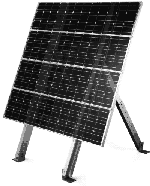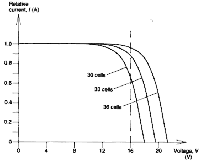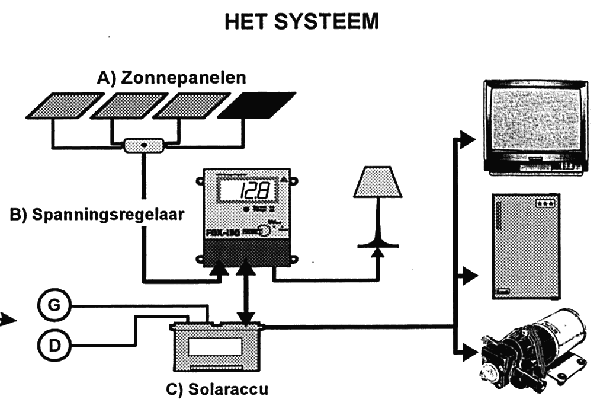PV-SYSTEMS: The small-scale energy source of the future.
Increasingly, PV-systems or solar panels are being used for electricity in remote areas.
PV stands for Photo Voltaic, which means sunlight is converted directly to electricity.
Although being a relative expensive energy source, its use will be growing in the future.
This is caused by some unique properties compared to other energy sources:
- The systems are durable and practically maintenance free.
- Sun is a constant energy source in most countries.
- The system is modular, begin at small scale and extend it when needed.
PV has also some disadvantages:
- The investments are relatively high.
- Storage of the energy is mostly necessary.
A PV-system consists of at least the following parts:
1 Solar panels
 The PV-panel is made from a number of solar cells. Each cell generates a voltage of about 0,45 V with a current proportional to the incoming sunlight. 30 - 36 cells are connected in series to generate 15-17 V at which lead-acid batteries can be charged directly.
The PV-panel is made from a number of solar cells. Each cell generates a voltage of about 0,45 V with a current proportional to the incoming sunlight. 30 - 36 cells are connected in series to generate 15-17 V at which lead-acid batteries can be charged directly.
Three kinds of solar panels are available nowadays:
Panels with monocristallyne cells. These can be recognised by a number of silicon discs, mostly cut to squares to arrange in a matrix. These cells have the highest power efficiency (14-18%) and a rectangular voltage-current characteristic, i.e. its maximum current is slightly higher than its nominal current at maximum power (3-10%).
Some cheaper are the polycrystalline cells. These are mostly rectangular at witch the panel surface is filled better.
In spite of their slightly lower efficiency per cell, the generated power per m2 panel is nearly the same as with monocristallyne cells.
In Thin-film solar panels, the about 30 cells are integrated as parallel lines in the panel.
These panels are made from amorf silicium in one part. Despite their low power efficiency (5-10%) they are cheaper per Watt.
 The voltage-current characteristic is nearly rounded, the nominal voltage and current are about 3/4 the open voltage or shortcut current. The nominal voltage is also slightly higher as with crystalline sillicium. Besides their large dimensions for a rated power, the live expectancy of 10 years is a disadvantage of this type of panel.
The voltage-current characteristic is nearly rounded, the nominal voltage and current are about 3/4 the open voltage or shortcut current. The nominal voltage is also slightly higher as with crystalline sillicium. Besides their large dimensions for a rated power, the live expectancy of 10 years is a disadvantage of this type of panel.
Figure 2 shows the voltage-current characteristic of the different types of panels.
The most usual panels have dimensions of 0,5 * 1 m and consists of a series chain of 30-36 cells which can deliver 3-4 Amps or 50 - 70 Watt. For larger power ratings than this, more strings (of 30-36 cells each) are connected in parallel.
Solar panels deliver about 100 - 140 W per square meter if they are exposed to full sunlight (1000W/m2). During one sunny day the specified power is available for effectively 5 hours, thus 500-700 Wh/m2 a day. Close to the equator available energy can reach 600-1000 Wh/m2 a day.
2 Battery
A battery is needed if the solar energy is used after sunset or with worse whether. Only water pumps or refrigerators with good heat isolation can do without because the energy is already stored in these.
The battery is used optimal if it is charged and discharged for less than half of its capacity in every cycle, so for daily use it must have a capacity of equal to the energy consumption of 2.5 - 5 days.
Its power efficiency is about 90%.
Car batteries are not recommended because of their high self-discharge (20%/month). For this purpose lead-calciumantimony batteries or solar batteries are used, they have a low self-discharge (2%/month) and have a long life expectancy (up to 7 years) if they are regularly used with limited large charge- and discharge currents. Storage with less than 40% of its charge for a long period will shorten its life-span.
Nickel-metal-hydride or nickel-cadmium seems much more expensive per Wh, but with their longer live expectancy and higher efficiency, they can be of interest. One advantage is that they can withstand full discharge so their capacity can be used fully.
The biggest problem with all batteries is their destination after use: mostly this is a local garbage mess or the environment. A good recycling program can prevent this problem. Recycling of lead batteries costs much less energy than the production of lead.
3 Battery charger
The battery has to be protected for overcharging or deep discharge. During charging the battery, voltage has to be limited to 15 V to prevent overcharging. During discharge, the load has to be switched off at low voltage to prevent deep discharge, which will demolish the battery. A built in diode prevents current flowing back from the battery to the panel at night. The voltage drop of 1 V in this diode reduces the power efficiency of the charger to about 93%.
However, in most chargers, the available power of the PV-panel is not used fully: Most panels deliver their maximum power at a voltage of about 17 V, much more than the actual voltage determined by the battery. This extra voltage is sometimes needed because it will drop at higher cell-temperatures.
While charging the battery the voltage is mostly 14-15 V, including the 1 V for the seriesdiode.
As a result of the rectangular voltage-current characteristic, the charging current is nearly the same as at the maximum power voltage of 17 V. In this way just 80% of the maximum power will reach the battery.
In a better, energy saving battery-charger the PV-voltage is converted to the (mostly) lower battery voltage with a high-efficiency DC-DC-converter in exchange to extra current. The series diode is replaced for a low drop active diode or a relay, so the overall efficiency can be 97%.
With this charger the use of bigger batteries has an extra advantage besides the longer life cycle: At the resulting lower charge voltage, the charging current will be higher.
With crystalline panels 15-20% more energy is available than with a conventional charger.
With thin film panels this charger is less useful, by their round voltage-current characteristic the power is nearly constant with a voltage between 13 and 16 V.
4 Inverter
An inverter converts the 12 or 24 V DC from the battery to 220 V AC (or 110 V AC). Most economical power consumers can operate from a low DC-voltage, at which the power consumption is much lower because the 50 Hz transformer is not needed. At small scale purposes (< 100 W) an inverter is mostly not needed and relatively expensive.
220 V AC is only needed for high power equipment. Large AC motors (for water pumps) can have a higher efficiency than smaller DC-motors.
Just as with PV-panels and batteries, most 220V-inverters are modular. They can be connected in parallel if the system is extended. Their power efficiency is high: 94-98%.
 TL-lamps or fluorescent tubes have to be used with good high-frequency inverters at 12 or 24 V. This results in 20% more light output with the same power compared with 50 Hz-inverters. Using very cheap HF-inverters for TL-lamps is not recommended; they limit the lifecycle of the tubes with a asymmetric high voltage and their power efficiency is bad.
5 Tracking system
A solar panel mounted on a tracking system, keeping the panel in the right orientation to the sun, generates up to 40% extra energy a day. A automatic tracking system is only of interest if it is cheaper than a 40% bigger solar panel area and the energy consumption of the necessary motor is very low compared to the extra generated energy. Manually tracking for twice a day can result in 35% more energy too. The panel has to be placed rotable on an axis which angle to horizontal is equal to the latitude.
A home made tracking system can reduce the costs of the relatively expensive solar energy.
The WOT has plans to built such system.
6 Placing of the panels
The right orientation for placing is depending on the time of the year when most energy is needed.
Because 20% of the current is generated by indirect sunlight, also the direct circumference around the panel has to be free from shadows of huge objects.
Besides light also ventilation is important. 85-90% of the incoming light is converted to heath so the cell temperature can get high. The maximum operating temperature is mostly 85 degrees and the generated voltage will drop with 70 mV per degree. Much airflow will increase the energy output. A safe and dust free place out of shadows is more important.
In wind free, tropical areas the cell temperature needs extra attention. This can reach 100 degrees, which can destroy the cells. The cell temperature rise can be measured by means of the decrease of the unloaded cell voltage.
7 Applications of solar energy
PV systems are pre-eminently suitable at remote places with no electric mains. Solar electricity is comparatively expensive energy so it is recommended to use electrical equipment with a low power consumption, which do usually operate from a low DC-voltage, 12 or 24 V. Possible applications with a low power consumption are:
| - Lighting, using TL- or SL- lamps in stead of bulbs. |
8-40 W |
or 48 - 240 Wh/day |
| - Communication equipment. (depending on range) |
3-100 W |
|
| - Refrigerator with extra heat isolation. |
40-100 W |
300-800 Wh/day |
| - Water pumps |
>200 W |
7-8 Wh/m4 |
The last 2 are usually sold with complete PV-systems included.
The necessary (daily) energy needed for water pumps can be estimated from the product of the amount of water (m3) and the depth from which it has to be pumped (m): m4
PV systems are not suited for electric heating, for this purpose solar collectors have a higher efficiency and are much cheaper.
Solar energy is not ideal for replacing a shortly interrupted mains supply. In this case a high power is required for a short time, this makes storage expensive. For this purpose a Diesel generator is more appropriate. If batteries are present to complete an unreliable mains, charging them with solar panels can be useful when the mains is interrupted for a longer period.
Example for calculating the system costs:
Solar panels are specified by their maximum generated power (Wp) if they are exposed to sunlight with an intensity of 1000 Watt per square meter, this is the average insulation at the earth's surface in an right orientation to the sun.
The daily available energy in Wh is 5 times this power in sunny countries till 6-7 times at the equator.
In northern countries the energy available varies from 1 Wh per Wp in the winter increasing to 5 Wh per Wp in the summer.
In the Netherlands the totally generated energy in 1995 was 1000 Wh per Wp.
With a tracking system the generated energy in Wh per Wp can be increased with 30 to 40% in all circumstances.
The life-span of a solar panel is at least 20 years. In this period the battery has to be replaced at least 2 times.
For the calculation of the system costs we assume a daily energy consumption of 250 Wh. For this energy consumption one solar panel of 50 Wp is required, the smallest unit available for a good price per Wp.
The requirements and costs of this system are:
| - One solar panel of 50 Wp |
$ 400 |
| - 3 batteries of 500 Wh (2 for replacement) |
3 x $ 60 |
| - 1 battery charger |
$ 40 |
| - Construction and cables etc. |
$ 50 |
| - 36 W TL-lamp with HF-inverter |
$ 100 |
| Total investment for 20 years: |
700 dollar |
This results in energy costs of about 40 dollarcent per kWh. The low maintenance costs and power consumers are not included. If more energy is needed daily, the system can be extended with more panels and/or more batteries.
They can simply be connected in parallel. With systems of 100 Wp and more this does not affect the costs per kWh.
10 years ago we could say that the production of solar cells would require more energy than they can generate during their life-span. The production methods of crystalline are improved strongly nowadays, so their energy costs are paid back after 2000 hours of sunlight or 1.5 years of uninterrupted use.
With thin film cells this would be half of it but their life-span is shorter too.
For more technical details about the purpose of solar cells we can reference to "Solar Electricity" from Simon Roberts.
Author: Paul Rebers. e-mail: rebix@xs4all.nl. Last update: 10-9-1997
|


 The PV-panel is made from a number of solar cells. Each cell generates a voltage of about 0,45 V with a current proportional to the incoming sunlight. 30 - 36 cells are connected in series to generate 15-17 V at which lead-acid batteries can be charged directly.
The PV-panel is made from a number of solar cells. Each cell generates a voltage of about 0,45 V with a current proportional to the incoming sunlight. 30 - 36 cells are connected in series to generate 15-17 V at which lead-acid batteries can be charged directly. The voltage-current characteristic is nearly rounded, the nominal voltage and current are about 3/4 the open voltage or shortcut current. The nominal voltage is also slightly higher as with crystalline sillicium. Besides their large dimensions for a rated power, the live expectancy of 10 years is a disadvantage of this type of panel.
The voltage-current characteristic is nearly rounded, the nominal voltage and current are about 3/4 the open voltage or shortcut current. The nominal voltage is also slightly higher as with crystalline sillicium. Besides their large dimensions for a rated power, the live expectancy of 10 years is a disadvantage of this type of panel.